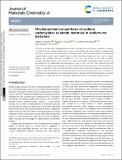Files in this item
Mechanochemical synthesis of sodium carboxylates as anode materials in sodium ion batteries
Item metadata
| dc.contributor.author | Rainer, Daniel N. | |
| dc.contributor.author | Desai, Aamod V. | |
| dc.contributor.author | Armstrong, A. Robert | |
| dc.contributor.author | Morris, Russell E. | |
| dc.date.accessioned | 2021-11-18T13:30:09Z | |
| dc.date.available | 2021-11-18T13:30:09Z | |
| dc.date.issued | 2021-12-28 | |
| dc.identifier | 276750499 | |
| dc.identifier | b4a694c3-7e44-4c4e-bfce-334b576cb1b6 | |
| dc.identifier | 85121484852 | |
| dc.identifier | 000718415800001 | |
| dc.identifier.citation | Rainer , D N , Desai , A V , Armstrong , A R & Morris , R E 2021 , ' Mechanochemical synthesis of sodium carboxylates as anode materials in sodium ion batteries ' , Journal of Materials Chemistry A , vol. 9 , no. 48 , pp. 27361-27369 . https://doi.org/10.1039/D1TA07897F | en |
| dc.identifier.issn | 2050-7488 | |
| dc.identifier.other | Bibtex: D1TA07897F | |
| dc.identifier.other | ORCID: /0000-0003-1937-0936/work/103510855 | |
| dc.identifier.other | ORCID: /0000-0001-7809-0315/work/103510949 | |
| dc.identifier.other | ORCID: /0000-0001-7219-3428/work/103511191 | |
| dc.identifier.uri | https://hdl.handle.net/10023/24358 | |
| dc.description | Funding: D. N. R. acknowledges funding through the EPSRC (EP/N509759/1). The authors thank the Faraday Institution for funding (Grant FIRG018). The authors also acknowledge the EPSRC Light Element Facility Grant (EP/T019298/1) and the EPSRC Strategic Equipment Resource Grant (EP/R023751/1). | en |
| dc.description.abstract | The ever-growing global energy demand necessitates, amongst other technologies, advances in materials for electrochemical energy storage such as sodium ion batteries. The recent advent of organic-based electrodes is driven by their tremendous structural versatility and the great potential in developing a green battery cycle. Current research aims to solve remaining obstacles such as a lack of robust, efficient and scalable synthesis procedures. In this vein, we present a fast and sustainable mechanochemical synthesis route towards four sodium carboxylates compounds. Target materials can be obtained in the substantially decreased reaction time of only one hour, while retaining the good electrochemical performance reported for conventionally synthesised compounds. More importantly, no solvent is required for these mechanosynthetic transformations, making this approach attractive with respect to goals in line with green chemistry as well as from an economical point of view. The variety of synthesised compounds hints at possible generalisability of the developed methodology and its potential applicability for many other known compounds, beyond the sphere of rechargeable battery systems. | |
| dc.format.extent | 9 | |
| dc.format.extent | 611045 | |
| dc.language.iso | eng | |
| dc.relation.ispartof | Journal of Materials Chemistry A | en |
| dc.subject | QD Chemistry | en |
| dc.subject | TK Electrical engineering. Electronics Nuclear engineering | en |
| dc.subject | NDAS | en |
| dc.subject.lcc | QD | en |
| dc.subject.lcc | TK | en |
| dc.title | Mechanochemical synthesis of sodium carboxylates as anode materials in sodium ion batteries | en |
| dc.type | Journal article | en |
| dc.contributor.sponsor | The Faraday Institution | en |
| dc.contributor.sponsor | EPSRC | en |
| dc.contributor.sponsor | EPSRC | en |
| dc.contributor.institution | University of St Andrews. School of Chemistry | en |
| dc.contributor.institution | University of St Andrews. EaSTCHEM | en |
| dc.identifier.doi | 10.1039/D1TA07897F | |
| dc.description.status | Peer reviewed | en |
| dc.identifier.grantnumber | EP/T005602/1 | en |
| dc.identifier.grantnumber | EP/T019298/1 | en |
| dc.identifier.grantnumber | EP/R023751/1 | en |
This item appears in the following Collection(s)
Items in the St Andrews Research Repository are protected by copyright, with all rights reserved, unless otherwise indicated.

